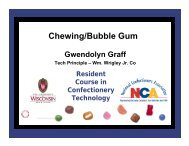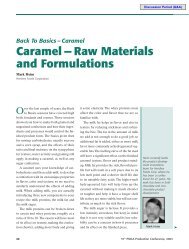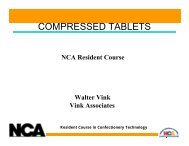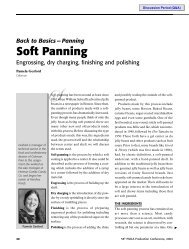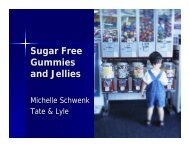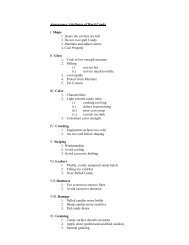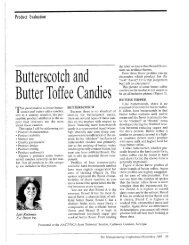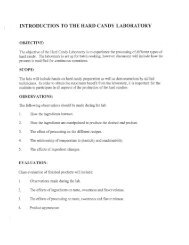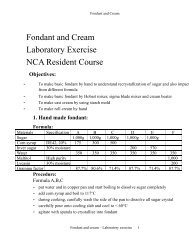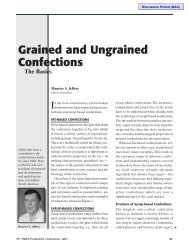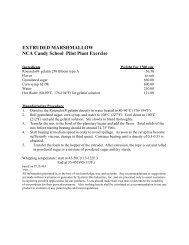Effect of DE of Corn Syrup - staging.files.cms.plus.com
Effect of DE of Corn Syrup - staging.files.cms.plus.com
Effect of DE of Corn Syrup - staging.files.cms.plus.com
You also want an ePaper? Increase the reach of your titles
YUMPU automatically turns print PDFs into web optimized ePapers that Google loves.
that are cooked for a long time at elevated temperatures would be expected to have the brownest color.<br />
Note that corn syrup has very little protein, but does have small amounts <strong>of</strong> amine <strong>com</strong>pounds, which<br />
are sufficient to promote Maillard browning. In these experiments, the brown color is indicated by the L<br />
value obtained from the Hunter colorimeter, with lower L values indicating more brown color.<br />
For a given cook temperature, we would expect the L value to decrease as the amount <strong>of</strong><br />
reducing sugars increased and cook time increased. When there is variability in replicates it is probably<br />
due to the differences in cook time. Formulations cooked to lower temperature would be expected to<br />
have less color.<br />
Glass transition temperature:<br />
The temperature at which the liquid syrup turns into a solid glassy matrix is the glass transition<br />
temperature (Tg), in this case measured by calorimetry. The two main factors that affect Tg are molecular<br />
weight <strong>of</strong> the sugars in the syrup and the final water content. In general, the more smaller molecular<br />
weight materials and the higher the water content, the lower Tg. In this experimental data set, both<br />
average molecular weight and water content varied with the formulations and cook process.<br />
One indicator <strong>of</strong> average molecular weight is the amount <strong>of</strong> reducing sugars present. In general,<br />
the higher the reducing sugar, the more smaller molecules are present and the lower the average<br />
molecular weight. Thus, we would expect a decrease in Tg with an increase in reducing sugars (lower<br />
average molecular weight).<br />
The second factor that affects Tg is water content. There is a decrease in Tg with increasing water<br />
content.<br />
Moisture sorption:<br />
The hygroscopicity, or propensity to pick up moisture from the environment, <strong>of</strong> a sugar glass<br />
depends primarily on the <strong>com</strong>position. It is well known that smaller molecules (like glucose and<br />
fructose) are more hygroscopic than larger molecules, even sucrose and especially the larger glucose<br />
polymers. Thus, we might expect a relationship between moisture sorption and reducing sugar content<br />
<strong>of</strong> our formulations. Moisture sorption may also be a function <strong>of</strong> water content since the ability <strong>of</strong> a glass<br />
to pick up moisture depends on how easily the molecules move around and make room for the water to<br />
penetrate the glassy matrix.<br />
Since Tg depends on both chemical <strong>com</strong>position and water content in much the same way as<br />
moisture sorption, it is interesting to explore the relationship between sorption and Tg. In a general<br />
sense, formulations that lead to lower Tg, either through addition <strong>of</strong> lower molecular weight <strong>com</strong>ponents<br />
or by adding water, result in more rapid moisture sorption.<br />
Other results:<br />
Some <strong>of</strong> the formulations were made in electric skillets instead <strong>of</strong> being heated in the copper<br />
kettles over open flame. Does the source <strong>of</strong> heat have any effect on the results?<br />
One formulation was made with all sucrose. Without the addition <strong>of</strong> corn syrup or invert sugar,<br />
there was nothing to inhibit the crystallization <strong>of</strong> sucrose and this formulation was seen to grain by the<br />
time it was poured onto the table. Another formulation was made with all invert sugar, a system that<br />
will not crystallize but will also not form a glass at room temperature. This system was still an<br />
amorphous fluid upon cooling on the table.<br />
Improvement <strong>of</strong> experiment:<br />
The primary uncontrolled variable in this experiment was the cook time. Some method <strong>of</strong><br />
controlling heating to minimize variations in cooking times would be beneficial for reducing the<br />
7



